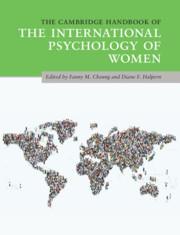Book contents
- The Cambridge Handbook of the International Psychology of Women
- The Cambridge Handbook of the International Psychology of Women
- Copyright page
- Dedication
- Contents
- Figures
- Tables
- Contributors
- Acknowledgments
- Section 1 The Underpinnings of Sex and Gender and How to Study Them
- Section 2 Developmental Perspectives of the International Psychology of Women
- Section 3 Cognitive and Social Factors
- Section 4 Work and Family Issues
- 19 Career Development of Women
- 20 The Psychology of Women in Entrepreneurship
- 21 Women’s Leadership across Cultures
- 22 Occupational Health Psychology and Women in Asian Contexts
- 23 Work–Family Interface and Crossover Effects
- 24 Intimate Relationships
- 25 Contextualizing the Many Faces of Domestic Violence
- Section 5 Inequality and Social Justice
- Section 6 Health and Well-Being
- Epilogue Some Final Thoughts and Take-Home Messages
- Index
- References
22 - Occupational Health Psychology and Women in Asian Contexts
from Section 4 - Work and Family Issues
Published online by Cambridge University Press: 20 July 2020
- The Cambridge Handbook of the International Psychology of Women
- The Cambridge Handbook of the International Psychology of Women
- Copyright page
- Dedication
- Contents
- Figures
- Tables
- Contributors
- Acknowledgments
- Section 1 The Underpinnings of Sex and Gender and How to Study Them
- Section 2 Developmental Perspectives of the International Psychology of Women
- Section 3 Cognitive and Social Factors
- Section 4 Work and Family Issues
- 19 Career Development of Women
- 20 The Psychology of Women in Entrepreneurship
- 21 Women’s Leadership across Cultures
- 22 Occupational Health Psychology and Women in Asian Contexts
- 23 Work–Family Interface and Crossover Effects
- 24 Intimate Relationships
- 25 Contextualizing the Many Faces of Domestic Violence
- Section 5 Inequality and Social Justice
- Section 6 Health and Well-Being
- Epilogue Some Final Thoughts and Take-Home Messages
- Index
- References
Summary
The focus of discussion in this chapter is on occupational stress and health of women in Asian contexts. There are similarities of occupational health and illness between Asian and Western women, and occupational health in Asian contexts is more related to culture, with working women expected to fulfill traditional modest feminist and family responsibilities. Two cases in Asian countries are examined in depth, Bangladesh and China, to illustrate the intersection role of culture and gender on occupational stress and health.
Keywords
- Type
- Chapter
- Information
- The Cambridge Handbook of the International Psychology of Women , pp. 317 - 328Publisher: Cambridge University PressPrint publication year: 2020
References
Suggested Readings

Oi-ling Siu is Chair Professor and Dean of Faculty of Social Sciences, Lingnan University, Hong Kong. She attended University of Strathclyde for her undergraduate degree, University of Hong Kong for her AdvDipEd and master’s degree, and University of Liverpool for her PhD. Her research interests include occupational stress, work–life balance and psychology of safety. She is one of the Top 25 work–family scholars in the world (Google Scholar, May 2017) and was awarded 2018 “Top 50” overall contributor to work and family research by Work and Family Researchers Network, Washington, DC. Siu is the Editor of International Journal of Stress Management and Associate Editor of Journal of Occupational Health Psychology.

Hai-Jiang Wang is an Associate Professor at the School of Management, Huazhong University of Science and Technology. Born in Shandong Province, he attended Zhengzhou University for his Bachelor of Engineering Peking University for his master’s degree in Industrial and Occupational Psychology, and Eindhoven University of Technology Netherlands for his PhD. He has worked in Lingnan University in Hong Kong for two years, and visited University of Verona for a month. His research areas include job design, work stress, and leadership. He is an editorial board member of the International Journal of Stress and Management.

Milan Pagon is a Pro-Vice Chancellor at the Independent University, Bangladesh (IUB) in Dhaka. He holds an ScD in Organizational Sciences (Human Resource Management) from the University of Maribor, Slovenia where he was born and raised, and a second PhD in Business Administration (Management/Organizational Behavior) from the University of Arkansas, Fayetteville, as a Fulbright Scholar. His research focus is on human resource management. Pagon has worked in Europe (Slovenia, North Cyprus, and Italy), the United States, and the United Arab Emirates, and has been living and working in Bangladesh for the last five years.



